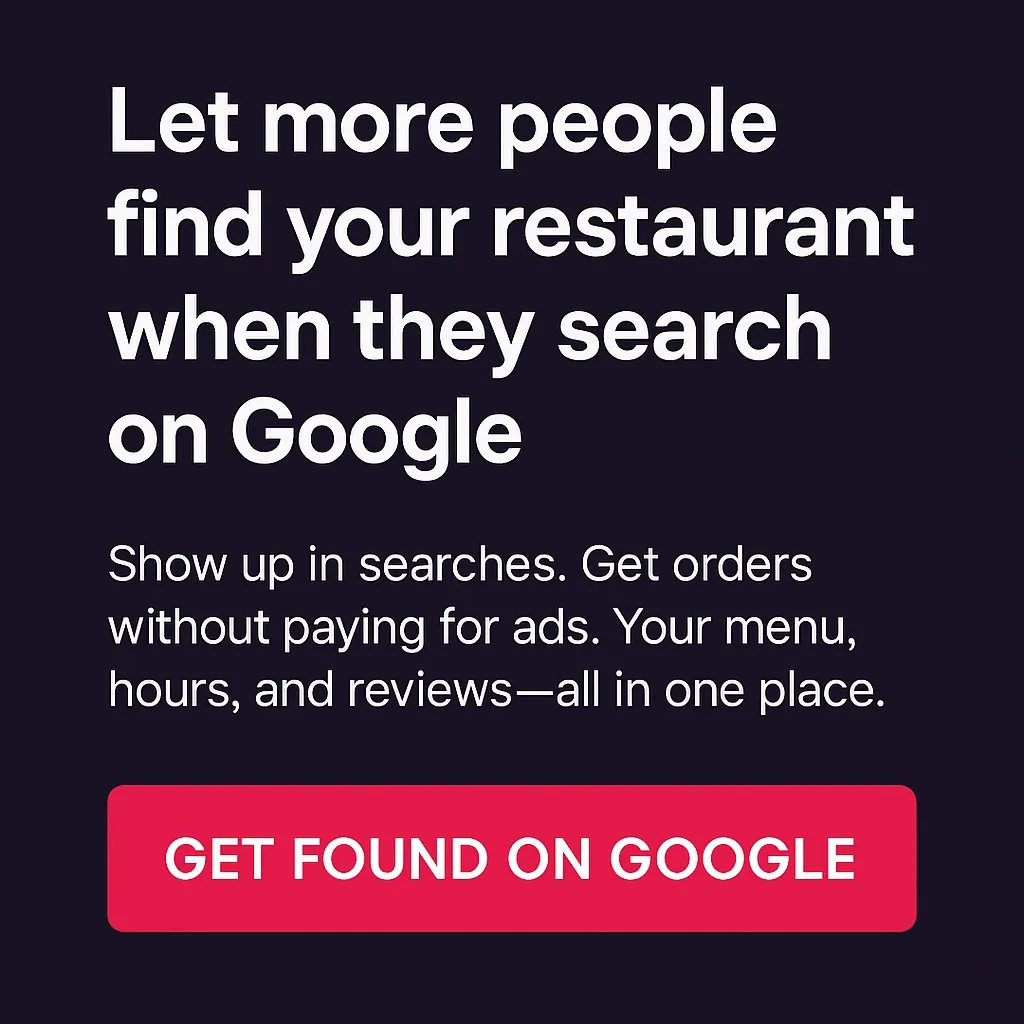
Running a restaurant is hard work. Marketing it online shouldn’t be. If you're tired of seeing competitors show up in search results while your tables stay empty, it’s time to look at restaurant SEO.
Whether you want to get found by more locals, increase online orders, or improve your Google visibility, SEO for restaurants is one of the most affordable and practical ways to grow. This guide will walk you through how to improve and optimize your restaurant website for SEO without spending thousands. Let’s get started.

SEO stands for Search Engine Optimization. It’s the process of improving your website so it shows up on Google and other search engines when people search for food near them.
For example, if someone types “best tacos near me” or “brunch in [your city],” SEO helps your restaurant appear in those search results. That means more people can find your menu, location, hours, and ordering options at the exact moment they’re deciding where to eat.
When done right, restaurant SEO can:
SEO for restaurants isn’t technical or expensive to get started. It’s about making simple improvements that help more people discover your business online.
More people now search on Google before deciding where to eat. They look for “best burgers near me” or “Italian food open now” and often pick from the first few results. If your restaurant doesn’t show up, you’re missing those potential customers.
That’s where restaurant SEO helps. It gives your business visibility exactly when someone is hungry and searching nearby. Local SEO improves your chances of showing up in map packs, organic results, and even review sites.
Restaurants use SEO to:
By showing up first, you get more traffic, more orders, and more bookings without paying for ads every time. SEO keeps working in the background so people can find you when they need food fast.

You don’t need a big budget or an agency to start seeing results from SEO. With a few practical steps, you can improve your online visibility and help more local customers find your restaurant when they search on Google.
Here’s how to do SEO for restaurants on your own:
Go to Google Business Profile, search for your restaurant, and claim it if it’s unclaimed. Then:
This listing often appears before your website, especially in “near me” searches.
Your Name, Address, and Phone Number (NAP) should be exactly the same everywhere online: your website, Google profile, Yelp, TripAdvisor, and social media pages.
Even small differences like “Street” vs. “St.” can confuse search engines and reduce your chances of showing up in local results.
Add location-based and cuisine-related keywords naturally into:
These keywords tell Google what your restaurant offers and where it's located.
Link your homepage to your menu, contact, and reservation pages. This helps visitors find what they need quickly and gives search engines more context.
Most people search for restaurants on their phones. A slow or broken site means lost traffic. Use tools like PageSpeed Insights to test your site and fix speed issues.
By following these steps, you’ll build a stronger foundation for local visibility. Starting with your own website and business listings keeps your costs low while giving you control over how your restaurant appears online.
Once your listings are in order, your website becomes the next key piece. Search engines want to show results that load fast, look great on mobile, and offer clear information. Here’s how to improve restaurant website SEO without overcomplicating it:
1. Speed up your site
A slow-loading page can push visitors away before they even see your menu. Use tools like Google PageSpeed Insights to check your site speed. Compress large images, reduce unnecessary plugins, and choose a lightweight theme if you’re using a platform like WordPress.
2. Make it mobile-friendly
Most customers search for restaurants on their phones. Your website should adjust smoothly to any screen size. Use large buttons, easy-to-read text, and clickable phone numbers for quick calls or reservations.
3. Use schema markup
Schema is structured data that helps Google display key info like your hours, location, menu, and reviews. You can add it manually or with tools like Google’s Structured Data Markup Helper. This helps your restaurant stand out with rich search results.
4. Simplify your site structure
Make it easy for visitors to find your menu, contact info, and booking options within one or two clicks. Use clear headings and avoid cluttered layouts. A clean structure also helps search engines index your content correctly.
5. Include local keywords naturally
Use phrases like “Mexican restaurant in Austin” or “best BBQ in Kansas City” in your homepage, about page, and title tags. Don’t stuff keywords. Use them where they fit naturally in your content.
6. Add internal links
Link your homepage to other key pages like your menu, online ordering, catering, or events. This keeps visitors on your site longer and helps search engines crawl your pages more efficiently.
Even small changes like these can improve SEO for your restaurant website. You don’t need to fix everything at once. Start with the basics, and build from there as your site gains traction.

To rank higher and attract more local traffic, your website needs more than just a good-looking homepage. Here's how to optimize your restaurant website for SEO in ways that are practical and effective:
1. Use Clear Headings and Subheadings
Structure each page using heading tags (H1 for the main title, H2 for sections, and so on). This helps search engines understand your content and helps visitors scan quickly.
2. Place Keywords Naturally
Use phrases people actually search for, like “vegan restaurant in Dallas” or “family-friendly brunch in Portland.” Include them in your page titles, meta descriptions, headings, and body content without forcing them.
3. Add Internal Links
Link from one page to another on your site. For example, your homepage should link to your menu, about page, and reservation page. This helps both users and search engines move through your site more efficiently.
4. Use Alt Text on Images
Every image, especially food photos, should have descriptive alt text (e.g., “spicy tuna roll with avocado”). This helps Google understand your content and improves accessibility.
5. Create Location-Specific Pages if Needed
If you operate in more than one location, create a separate page for each one. Include the city name, address, and unique content for each. This increases your chance of appearing in local searches for each area.
Apply these steps consistently to strengthen your visibility and traffic. If you’re focusing on how to optimize a restaurant website for SEO, start with these basics. They help search engines rank your site and help people find your restaurant when it counts.
Building a website with search visibility in mind starts with a few smart, practical choices. Search engines look at structure, content, and usability—so should you. Here’s how to create a restaurant website with SEO from the start:
1. Use a mobile-responsive design
Most people search for places to eat on their phones. Your site needs to load quickly, display cleanly on small screens, and make it easy to click, scroll, and order. Mobile performance directly affects rankings and user experience.
2. Make your menu crawlable
Search engines can’t read image-based PDFs. If your menu is only available as a photo or scanned document, you're missing traffic. Use HTML or text-based formats so Google can index your dishes, keywords, and specials.
3. Structure your pages clearly
Each page should have a specific purpose: home, menu, contact, and reservations. Use simple navigation and clear headings. This helps both users and search engines find what they need fast.
4. Write keyword-focused content
Include location, cuisine, and services in your page titles, headings, and descriptions. For example, “Authentic Mexican Restaurant in Milwaukee” gives Google a clear idea of what you offer and where.
5. Add reviews and testimonials
Social proof helps rankings and builds trust. Show recent reviews on your homepage or create a dedicated section for customer feedback. Use real quotes and update them regularly.
6. Include local signals
Mention your city or neighborhood throughout your site, not just on the contact page. Add a Google Maps embed and list any local partnerships or events you’re part of.
Designing with SEO in mind means your site works better for visitors and ranks higher over time. Keep it simple, structured, and focused on what people search for when they want to find food like yours.
Yes, blogging helps your restaurant website rank higher in search results. It gives Google fresh content to index and gives potential customers more ways to find you online.
When you write about what you serve, what you’re known for, or what’s happening at your location, you naturally include keywords people search for. Over time, that builds your visibility in local searches.
Blog posts don’t need to be long or complicated. Focus on topics that show what makes your place unique or helpful to diners:
If you post once or twice a month, you give search engines a reason to revisit your site. That helps you stay relevant and improves your chance of ranking for specific keywords related to your food, location, and service.
Blogging also keeps your website active and helps convert visitors into paying customers by showing personality and trust. So, if you’re thinking, is blogging good for restaurant SEO? The answer is yes. Start small and be consistent.

The cost of restaurant SEO depends on how involved you want to be and how much support you need. You can keep things low-cost if you're doing it yourself, or pay more for hands-on help. Here's a simple breakdown:
Handle the basics using free and affordable tools.
This is a good option if you’re comfortable updating your site, writing content, and managing listings.
Get help without hiring a full agency.
This route saves time while giving you room to stay involved and learn as you go.
Agencies usually provide full-service SEO with reporting, strategy, and content creation.
It’s the most expensive option, but also the most hands-off.
If you're wondering how much is restaurant SEO, the short answer is: you control the pace. You can start small, test what works, and invest more once you see consistent results. The effort builds over time, and unlike ads, the benefits don’t disappear when you stop spending.

You don’t need a big budget to get results from SEO. A few focused efforts each month can lead to steady growth in traffic, online orders, and reservations. Here’s how to start small and build over time:
1. Block out time each month
Set aside a few hours to update your website, check local listings, and add fresh content like photos, menu updates, or a blog post. Small, regular updates help keep your site active and relevant to search engines.
2. Work with a freelancer
Hire a local SEO specialist or freelancer for a few key tasks, like keyword research, setting up Google Business Profile, or fixing technical issues. It’s a cost-effective way to get professional input without a full retainer.
3. Use local SEO tools
Platforms like BrightLocal or Moz Local help manage listings, monitor reviews, and track search rankings. These tools save time and help you stay visible in local search results.
4. Train your team on the basics
If you have a manager or staff member who handles digital tasks, give them a simple SEO checklist. Things like posting updates, replying to reviews, or uploading photos can all support your SEO goals.
SEO works best when you treat it as a long-term investment. Start with the essentials, stay consistent, and build from there.
Improving your restaurant website for SEO doesn’t require a big spend or outside help. A fast-loading site, consistent business info, and a few well-placed keywords can help more local diners find you right when they’re searching. Focus on clear content, mobile usability, and regular updates. These efforts build visibility over time and bring in traffic that doesn’t depend on ad spend.
If you want to take things a step further, Chowbus POS can help streamline your growth. With full Google-powered ordering integration, customers can find your restaurant, browse your menu, and place orders right from Google Search without any extra clicks. You'll also benefit from SEO-optimized listings, faster ordering experiences, and badges like “Preferred by Business” and “Ready in 1–10 mins” that build trust and drive conversions.
Book a free demo with Chowbus POS today and see how better SEO and better ordering systems can work together to bring more customers through your doors.
Getting your restaurant found online doesn’t have to be overwhelming. These quick answers cover what works, how long it takes, and where to start.
Focus on these four must-dos:
Start with these to see the fastest results.
SEO helps restaurants show up in local search results when people look for places to eat. It drives more traffic to your website, increases visibility on Google Maps, and brings in more walk-ins, reservations, and online orders without paying for ads.
SEO typically takes 3 to 6 months to show noticeable results. Local SEO efforts, like optimizing your Google Business Profile, can start improving visibility in a few weeks. Consistency and ongoing updates help maintain and grow results over time.
Need more tips like this? Check out our blog section for fresh insights and updates on restaurant growth, marketing, and technology.

DISCLAIMER: The information provided in this blog is for general educational purposes only and does not constitute professional advice. Results from SEO efforts may vary based on your location, competition, website structure, and other factors. Always consult with a qualified SEO specialist or web professional before making significant changes to your website or marketing strategy.
Recommended Articles: